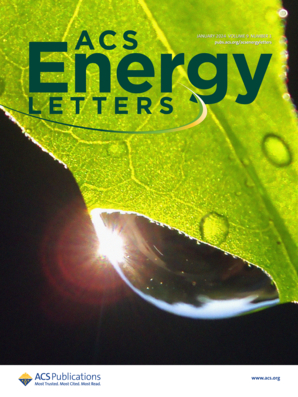Modulating Solvation Structure in Concentrated Aqueous Organic Redox Flow Battery Electrolyte for Solubility and Transport Enhancement via Polycomplex Ion
IF 19.3
1区 材料科学
Q1 CHEMISTRY, PHYSICAL
引用次数: 0
Abstract
Aqueous organic redox flow batteries hold great promise as a technology for creating economical grid energy storage using sustainable materials. Nonetheless, the solubility limit presents a universal barrier for all redox-active organic molecules. In this paper, a new approach is proposed to surpass the solubility limit by manipulating the solvation structure with polycomplex ion additives (PIA). Using poly(3,4-ethylenedioxythiophene) polystyrenesulfonate colloids as one example, its role in dismantling the rigid supramolecular clusters within the highly concentrated 7,8-dihydroxyphenazine-2-sulfonic acid electrolyte is investigated. 1H and 23Na NMR spectra and molecular dynamics simulation studies demonstrate that the bipolar structure of the PIA effectively disrupts the aggregations of DHPS and Na+ ion in the highly concentrated anolyte, thus rendering a more flexible solvation structure and less restrictive ion transport, leading to substantially improved battery performance of an AORFB cell. The anolyte with PIA achieved 1.6 M and 74.3 Ah L–1 anolyte energy capacity.

通过多络合物离子调节浓水有机氧化还原液电解液的溶剂化结构以增强其溶解度和输运
水性有机氧化还原液流电池作为一种使用可持续材料创造经济电网储能的技术,前景广阔。尽管如此,溶解度限制为所有氧化还原活性有机分子提供了一个普遍的屏障。本文提出了一种利用多络合离子添加剂(PIA)控制溶剂化结构来突破溶解度极限的新方法。以聚(3,4-乙烯二氧噻吩)聚苯乙烯磺酸胶体为例,研究了其在高浓度7,8-二羟基吩-2-磺酸电解质中分解刚性超分子团簇的作用。1H和23Na核磁共振谱和分子动力学模拟研究表明,PIA的双极性结构有效地破坏了高浓度阳极液中DHPS和Na+离子的聚集,从而使溶剂化结构更加灵活,离子传输限制更少,从而大大提高了AORFB电池的电池性能。经PIA处理的阳极液能量容量为1.6 M, L-1容量为74.3 Ah。
本文章由计算机程序翻译,如有差异,请以英文原文为准。
求助全文
约1分钟内获得全文
求助全文
来源期刊

ACS Energy Letters
Energy-Renewable Energy, Sustainability and the Environment
CiteScore
31.20
自引率
5.00%
发文量
469
审稿时长
1 months
期刊介绍:
ACS Energy Letters is a monthly journal that publishes papers reporting new scientific advances in energy research. The journal focuses on topics that are of interest to scientists working in the fundamental and applied sciences. Rapid publication is a central criterion for acceptance, and the journal is known for its quick publication times, with an average of 4-6 weeks from submission to web publication in As Soon As Publishable format.
ACS Energy Letters is ranked as the number one journal in the Web of Science Electrochemistry category. It also ranks within the top 10 journals for Physical Chemistry, Energy & Fuels, and Nanoscience & Nanotechnology.
The journal offers several types of articles, including Letters, Energy Express, Perspectives, Reviews, Editorials, Viewpoints and Energy Focus. Additionally, authors have the option to submit videos that summarize or support the information presented in a Perspective or Review article, which can be highlighted on the journal's website. ACS Energy Letters is abstracted and indexed in Chemical Abstracts Service/SciFinder, EBSCO-summon, PubMed, Web of Science, Scopus and Portico.
 求助内容:
求助内容: 应助结果提醒方式:
应助结果提醒方式:


